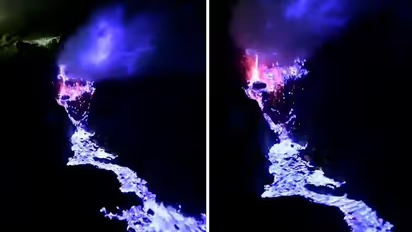Mystical glow: Video of electric blue flames erupting from Indonesia's Kawah Ijen volcano goes viral (WATCH)

Synopsis
As the viral video continues to capture the world's imagination, the mystique of Kawah Ijen endures, inviting further exploration and appreciation of the Earth's extraordinary natural phenomena.
In the mystical landscapes of Indonesia, the Kawah Ijen volcano has become a spectacle of natural wonder, captivating the world with its mesmerizing display of electric-blue flames. A recently resurfaced video, captured by photographer Olivier Grunewald, showcases the unique phenomenon that sets the Ijen volcano apart from others. In an interview with National Geographic, Grunewald explained that the dazzling blue glow emanates from the combustion of sulphuric gases, not from the traditional lava flows that one might associate with volcanic eruptions.
While the Ijen volcano itself is no different from other volcanoes, the distinctive blue lava phenomenon is attributed to the abundance of sulphur pockets in the rock. As sulphur is released from cracks in the volcanic rocks at high pressure and temperature, it reacts with the air to form sulphur dioxide, a noxious gas. The combustion of this gas at temperatures above 360 degrees Celsius creates the striking blue flames that dance across the landscape.
Also read: Chinese family of 8 makes luxurious hotel their new home; pay Rs 11,000 per day (WATCH)
Olivier Grunewald, a photographer from France who has dedicated himself to capturing the raw beauty of volcanic eruptions, emphasized that the vibrant blue glow is not lava. Contrary to some misconceptions, it is a result of the combustion of sulphuric gases in contact with air. The surreal footage, originally part of a documentary released in collaboration with Geneva's Society for Volcanology, has once again gone viral on social media, reigniting interest in the captivating natural phenomenon.
Beyond its aesthetic allure, the Kawah Ijen volcano has practical implications for the local community. Miners residing in the vicinity of the volcano extract sulphuric rock, formed after the blue flames have subsided, for use in various industries such as food and chemicals. Carrying rock-filled baskets by hand down the mountain, these miners sell the sulphuric rocks for approximately 680 Indonesian rupiahs per kilogram, equivalent to about six cents. Despite the low price, miners can carry between 80 to 100 kilograms over 12 hours of work, earning them around $5 to $6.
Situated within a crater formed by previous volcanic activity, the vast Ijen volcanic complex boasts approximately 22 eruption points, primarily around the caldera's rim. The complex's acidic lake, formed by the volcanic eruption, is renowned as the largest acid lake globally, boasting a pH value of zero. Experts caution against swimming in the lake, as it poses potential life-threatening risks.
Check the Breaking News Today and Latest News from across India and around the world. Stay updated with the latest World News and global developments from politics to economy and current affairs. Get in-depth coverage of China News, Europe News, Pakistan News, and South Asia News, along with top headlines from the UK and US. Follow expert analysis, international trends, and breaking updates from around the globe. Download the Asianet News Official App from the Android Play Store and iPhone App Store for accurate and timely news updates anytime, anywhere.